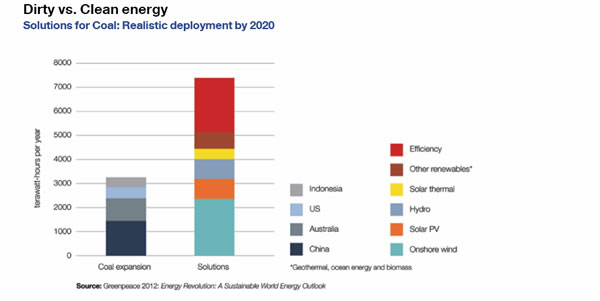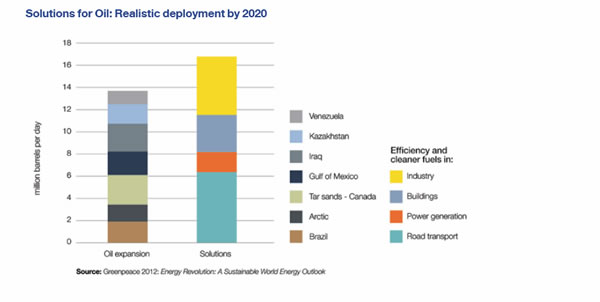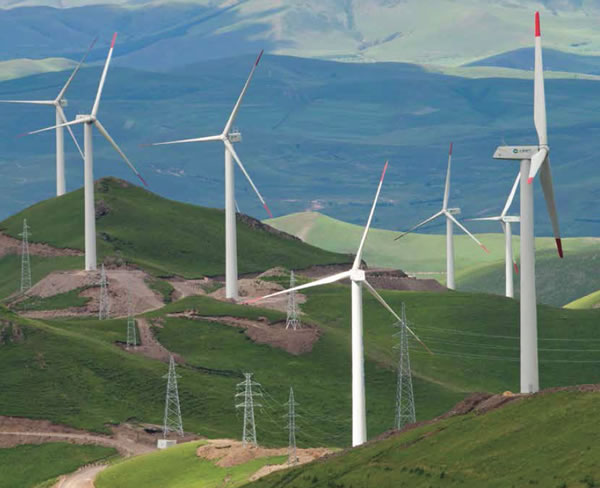|
Environment and communities do not need to be put at risk for the sake of extracting more coal to produce electricity. Governments have
a choice. They could continue to support the planned expansion of the US, Australian, Indonesian and Chinese coal operations, which would
pump an additional 3 billion tonnes of carbon pollution into the atmosphere every year, leading to untold environmental consequences. Or,
governments could turn away from using coal for electricity production and champion renewable energy.
Greenpeace had developed a global Energy [R]evolution scenario that shows how to make the transition from dirty coal to renewable power
by using existing renewable energy technologies and by increasing energy efficiency. If the current rate of growth in the renewable energy
sector is maintained, wind and solar energy would overtake coal in electricity production in less than 15 years. The Energy [R]evolution
scenario shows how coal-fired power generation could be eliminated as existing facilities retire, and how the world’s power needs
could be met with clean energy without building new coal plants.
The global Energy [R]evolution scenario shows that a range of already existing technologies – from solar to wind, ocean and geothermal
– could replace electricity generation from coal, based on what suits a local situation. For example, Spain, with its abundance of
sun, has become a leader in concentrated solar thermal power, while Denmark with its windy coastline makes investment in offshore wind
plants its priority. Electricity would also be generated locally – creating local jobs – without the need to rely on outdated
national infrastructure that is costly to maintain. Renewable energy – if subject to the right development conditions, and if unfair
barriers such as fossil fuel subsidies are removed – has the potential to be a massive global employer. The Energy [R]evolution shows
renewable energy could employ up to 8 million people by 2020, compared to the coal industry’s 2.8 million.
A key part of doing away with dirty fossil fuels is to ensure energy is used more efficiently. This will result in better products that
waste less energy and that reduce energy costs to consumers. Implementing a strict technical standard to ensure all electrical appliances
are designed to be as energy efficient as possible would mean it would be possible to switch off more than 340 coal-fired power plants
in OECD countries, removing 2,000Mt of CO2. Efficient lighting alone could close 80 coal-fired power plants, reducing CO2 emissions by
500Mt. Even bigger gains in demand reduction could be realised if entire systems – such as houses and cars – were rethought
and made more efficient.


Transitioning to renewable power generation would also save more money than retaining conventional electricity sources. The reference scenario
in the Energy [R]evolution shows the impact of continued reliance on dirty energy sources would be $1.3 trillion more a year – almost
$200 per person globally – spent on coal, oil and gas, than the no-fuel-cost pathway of the Energy [R]evolution. Overall, thanks
to better energy efficiency and lower fuel costs, less money would be spent on power generation on the renewable energy pathway than on
the dirty energy pathway.
An impressive roll out of renewable technology is already occurring. Renewable energy is now providing more than 30% of new electricity
production globally. By 2035 renewable energy could be increased to 65% of electricity production, and energy efficiency could be significantly
increased, according to the Energy [R]evolution, to avoid the catastrophe of passing the point of no return. Clearly, renewable energy
could turn the tide against coal. The world does not need the coal reserves in the US, China, Indonesia and Australia to be dug up and
burned. Alternatives exist, and are being used right now.
About 54% of the 77 million of barrels of oil burned each day is used for transportation, in cars, trains, planes and ships. The remaining
barrels are used to provide heat for buildings and industrial processes as well as to generate some electricity.
If the fossil fuel industry is allowed to drill as much as it wants in waters off Brazil and in the Arctic, and to mine Canada’s
tar sands, it could produce 10 million barrels of oil a day from these sources alone. That’s enough to fill 4,000 huge oil tankers
a year.
But governments don’t need to push the climate to the point of no return and risk these pristine environments to appease the global
addiction to oil. By implementing simple policies, such as upgraded fuel economy standards or transitioning to alternative technologies
such as electric cars and renewable sources of power and heating, dramatic cuts can be made in demand for oil by more than the dirty oil
projects would produce.
The Energy [R]evolution scenario shows that – through a combination of ambitious efforts to introduce higherefficiency technologies
for vehicles, a major switch to electric vehicles and incentives for travellers to save CO2 – it would be possible to reduce transport
emissions by 40% in 2050, compared to 2007 levels.
In the US, fuel economy standards introduced in the 1970s to ensure new cars used less fuel are already saving approximately 2.8 million
barrels a day, almost equal to the targeted oil production in the Arctic. Updating this policy to reflect advances in technology and rolling
it out globally could save 15 million barrels, not to mention the millions that car owners would save when filling their tanks.
Advances are being made in batteries for electric cars all the time. A 2010 Deloitte report estimated that by 2020 electric and other “green”
cars will account for one third of total global car sales, while Nissan CEO Carlos Ghosn predicts that one in ten cars globally will run
on battery power alone by 2020. Nissan has sold 27,000 all-electric model Leaf cars since its introduction in 2010, with forecasts for
sales of 1.5 million zero-emission cars by 2016. Governments around the world are also beginning to support the electric-car industry with
the US pledging $2.4bn US dollars in federal grants for electric cars and batteries. China has provided $15bn to kickstart its electric
car industry, with further subsidies for transition technology. If just 10% of driving were done in electric vehicles, more than 2 million
barrels of oil would be saved every day.
Greenpeace’s Energy [R]evolution scenario has shown how demand for oil could be reduced in other transport sectors. Truck and ship
freight could use less oil by improving their load handling to maximise the space available. Increasing electric train use would also help,
as trains are the most efficient form of transport. New technology would also dramatically help improve transport efficiency. For example,
a 65% reduction in fuel use is possible in new aircraft by 2050. Further policy measures that would encourage a reduction in passenger
transport demand include incentives for working from home, stimulating the use of video conferencing in businesses and improved cycle paths
in cities.
The remaining oil currently used in temperature control of buildings and in industry could also be replaced with cleaner fuels, including
renewable electricity, sustainable plant-based bio oils, solar heating and district heating and cooling. Demand can be reduced through
the implementation of smarter technology and energy efficiency policies.
For example, new buildings could be built to require minimal energy for heating and cooling, as is the case in tens of thousands of buildings
in Germany and elsewhere in Europe. Or, buildings undergoing major renovation could be required to use renewable energy to provide a certain
proportion of their heating and cooling, as is already in place in Australia and some other countries. Governments should also promote
combined heat and power (CHP), which uses the heat generated during production and manufacturing that would normally be wasted and turns
it into a source of energy that can heat buildings and water in the surrounding area.
Adopting policies to support energy-saving technology such as CHP, low-energy houses, as well as using cleaner fuels and renewable energy,
would save another 9 million barrels of oil a day, making the assured destruction of environments such as the Arctic, Brazil’s coastline
and Canada’s Boreal Forests completely unnecessary.

|